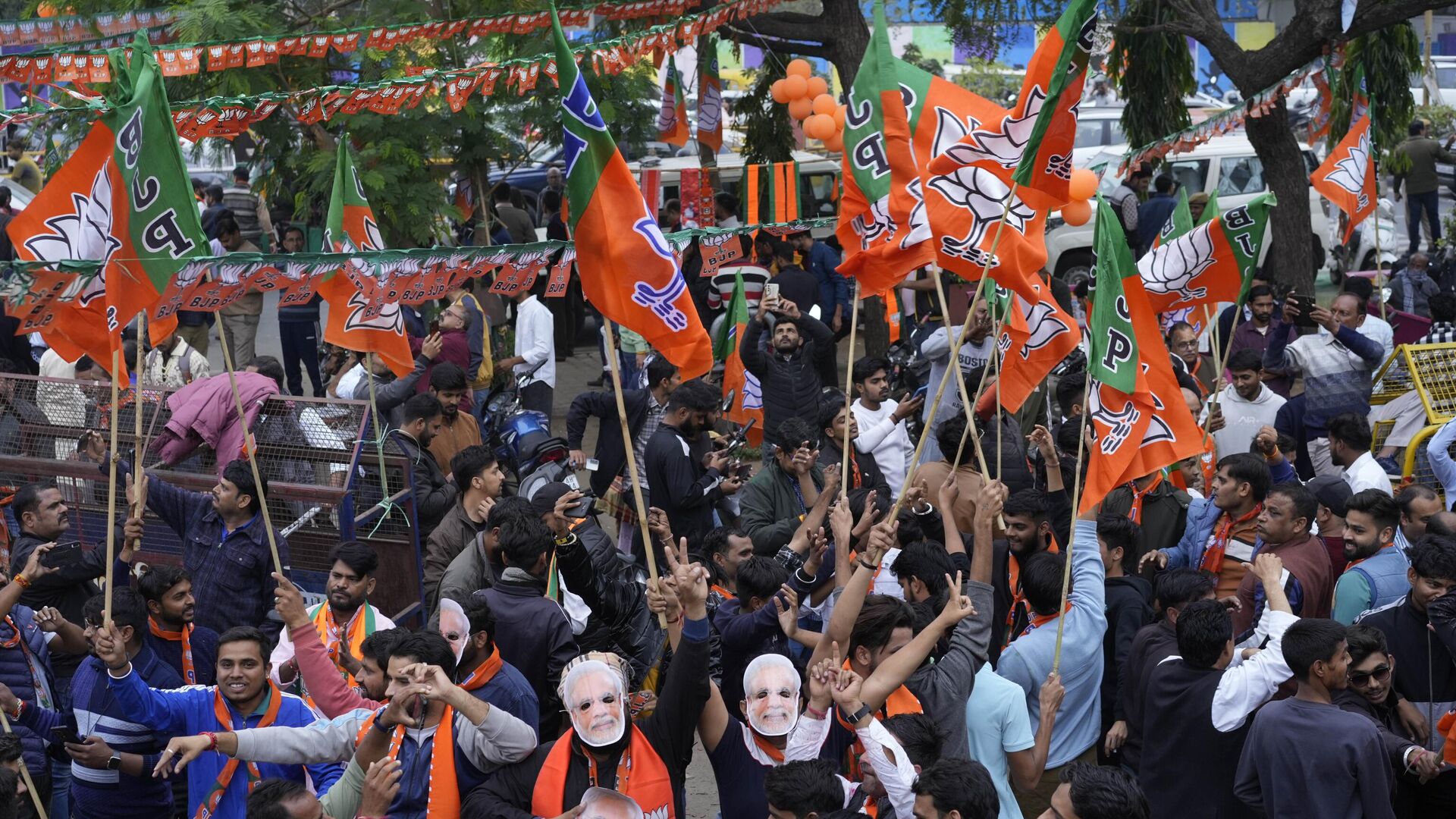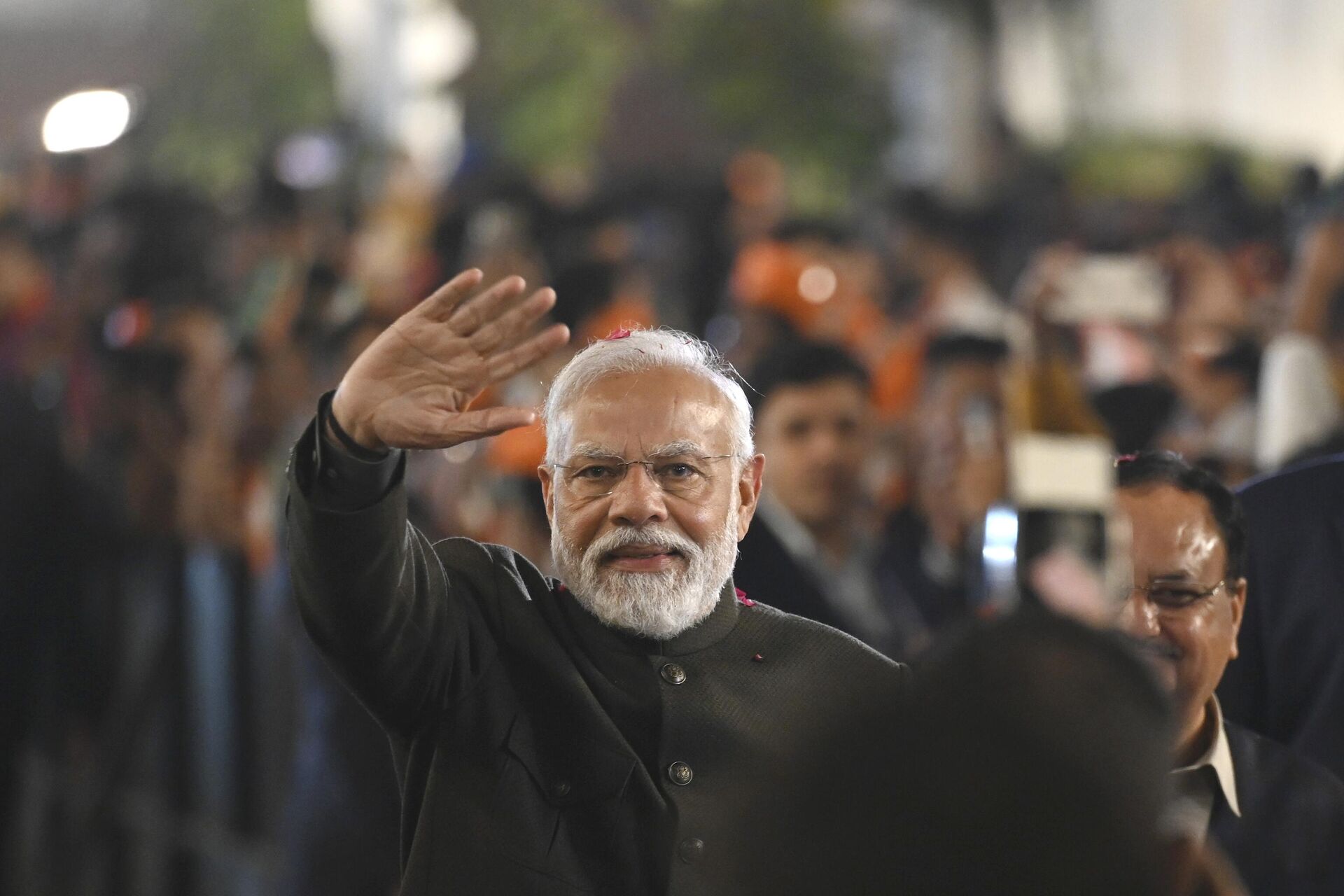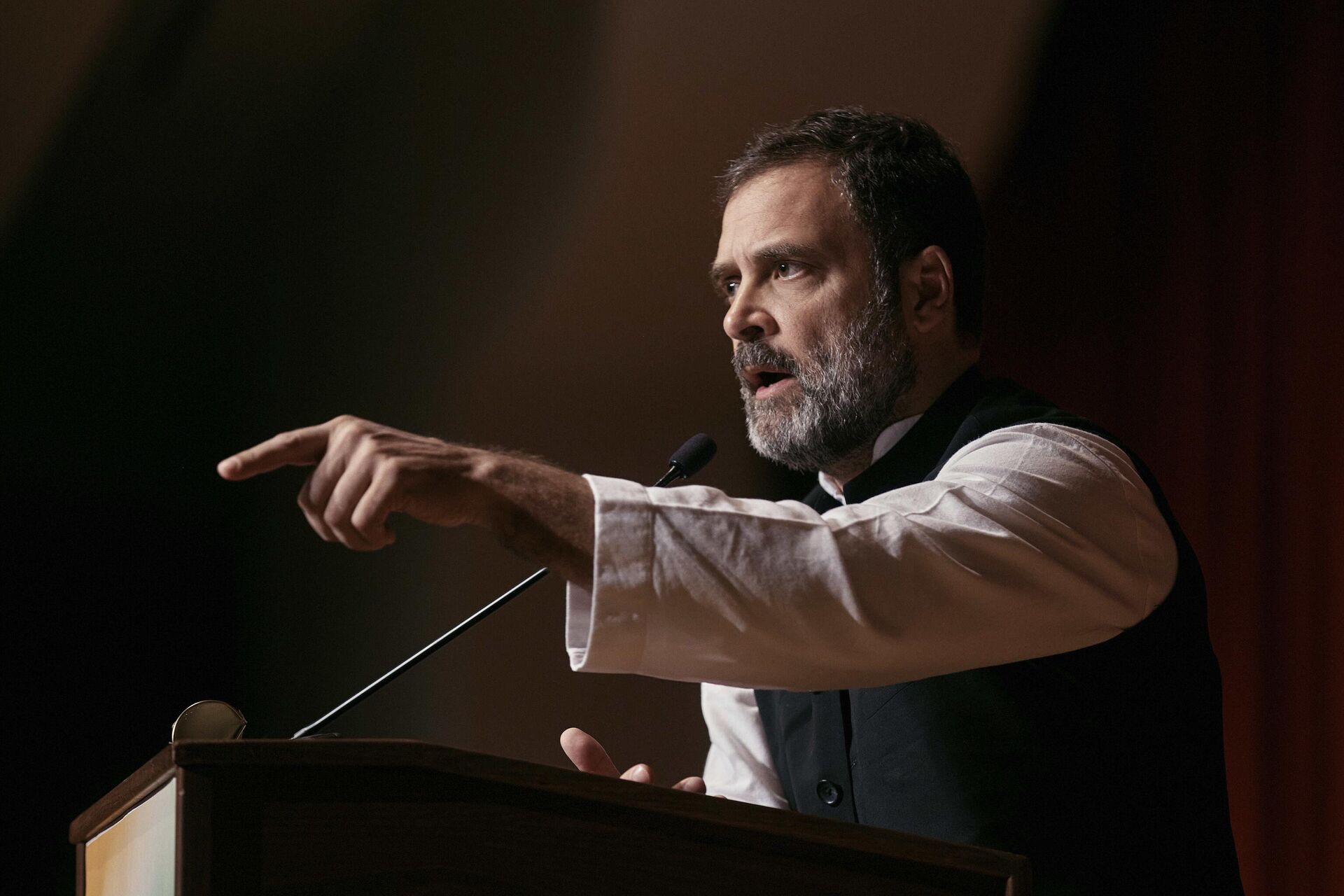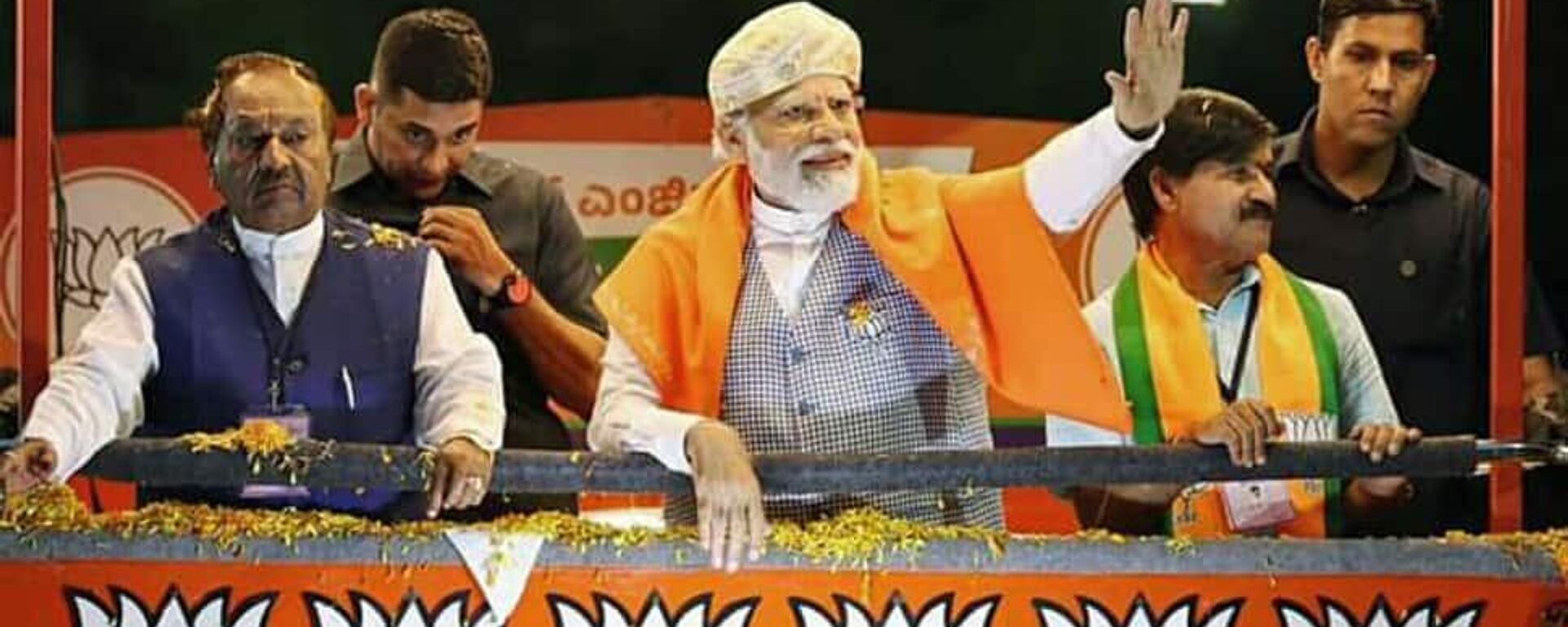https://sputniknews.in/20240108/is-india-heading-for-unequal-fight-in-2024-elections-6129725.html
Is India Heading for Unequal Fight in 2024 Elections?
Is India Heading for Unequal Fight in 2024 Elections?
Sputnik India
Ahead of India's general elections, the BJP leads over a divided Opposition. The ruling party gains momentum, while internal conflicts weaken the Opposition's chances.
2024-01-08T20:46+0530
2024-01-08T20:46+0530
2024-01-09T13:43+0530
sputnik opinion
rahul gandhi
arvind kejriwal
narendra modi
india
delhi
west bengal
bharatiya janata party (bjp)
aam aadmi party (aap)
trinamool congress
https://cdn1.img.sputniknews.in/img/07e7/0c/03/5689066_0:160:3072:1888_1920x0_80_0_0_4bb15d5c4edc465144977d8ea1e4eef5.jpg
General elections in India are only a few months away. The contest between the ruling front and the newly formed Opposition alliance is increasingly looking unequal, nowhere near the battle of titans Indians elections have been over the past several decades. In large measure, this perception is triggered by the outcome of the elections held late last year in four states that were seen as an indication of a larger trend in the national elections of this year. BJP, the ruling coalition leader, won in three of four, surpassing forecasts. Notwithstanding the hardship of the people of the country and joblessness, the Opposition parties failed to convert such sentiments into their advantage in the polls.The triumph of the National Democratic Alliance (NDA) spearheaded by Prime Minister Modi has inspired a renewed trust in the ruling government. High-level corporate executives who had blamed the BJP-led alliance in private chats until then have now begun to make statements in praise of Modi, both in public statements and private conversations. Perhaps they sense that the outcome of this year’s general election is a foregone conclusion with poll momentum disproportionately favouring Modi and company. Maybe they feel emboldened by the trend in stock markets that tend to back stability.True, election results are unpredictable, just as the outcome of the recent state elections in India was, but certain factors are indicators of which way the wind is blowing. One, of course, is the enthusiasm of corporations, which, as of now, are gung-ho about the incumbent prime minister and his stature in comparison with opposition politicians. Collectively, they supply a huge chunk of the money that is used up for election campaigns. The BJP received Rs 259 crore or 70.69% of the total donations received by all political parties from electoral trusts in 2022-23.In mid-2023, several Opposition parties joined hands with an ambitious goal of forging an anti-BJP coalition with the aim of dislodging Modi from power. And yet, the news coming from the entity conceived as a counterweight to the ruling NDA is nothing to cheer about. Rather than inspiring confidence among its previous vote banks, the so-called I.N.D.I.A. alliance, now a grouping of 28 disparate political entities, including the Congress, appears to have scared off potential supporters over time thanks to internecine wrangling.If the I.N.D.I.A. bloc had been a cohesive entity, the BJP-led formation would have sensed a challenge. So far, it is not so, and fissures within suggest that the Opposition combo is in a bad spot when it comes to fair accommodation of multiple interests. If the Congress – also called the Grand Old Party – had won more than or at least two states of the four states that went to the polls in late 2023, it would have had the legitimate right and bargaining capacity to demand a greater share of seats from the rest of the I.N.D.I.A. bloc in the Lok Sabha polls, including in states where its allies are stronger than the Congress. But losing polls has come with a price for the party controlled by the Nehru family. Constituents of I.N.D.I.A., especially regional parties, are not playing ball. In West Bengal, I.N.D.I.A.'s ally Trinamool Congress, steered by state chief minister Mamata Banerjee, isn’t ready to share any more than two Lok Sabha (lower House of Parliament) seats from the state. Out of 543 seats in the Lok Sabha, 42 are from West Bengal. In Maharashtra, which sends 48 lawmakers to the Lok Sabha, I.N.D.I.A. partner Shiv Sena (UBT) hasn’t yet arrived at a seat-sharing formula with the Congress. In Punjab and Delhi, I.N.D.I.A. bloc allies Congress and the Aam Aadmi Party (AAP) are busy taking digs at each other. There are no signs that both these entities are likely to end their hostilities anytime soon.For its part, the Congress is not keen to usher in more cohesion within I.N.D.I.A. Sample this: the grand old party cold-shouldered a proposal by Mamata Banerjee and AAP chief and Delhi chief minister Arvind Kejriwal to name Congress president Mallikarjun Kharge as the PM candidate. They argued that Kharge is a quintessential politician who rose through the ranks and is a Dalit. Fielding him would mean a decent political move to revive the opposition’s chances of building a narrative around pitching a Dalit for PM. No Dalit has ever been prime minister in India till date. Kejriwal brought in the perspective that Dalits are a stable and cohesive vote bank across India besides the Brahmins and the Muslims. Other communities do not have such strong allegiance or commitment to getting their folk elected, goes the logic.Without a doubt, Kharge as the PM face of the I.N.D.I.A. bloc would have breathed new life into the Opposition’s campaign and put the ruling party on the defence, at least in a small measure, if not a big one. The Opposition, which currently lacks a message to counter the ruling BJP and its tireless campaigning to pull in votes across socioeconomic segments, would have had a messenger who himself would have been the message. It would have been a masterstroke of a political narrative. Interestingly, close to 17% of Indians are Dalit and the “give Dalits a chance” chorus would have helped the anti-BJP front grab a much-needed electoral stimulus.In sharp contrast to I.N.D.I.A. and Congress, the ruling party BJP is connecting with people at a fast clip through its various programmes to win over those who were beneficiaries of its national welfare schemes. The Opposition campaign doesn’t seem to be any match for the BJP’s. Rather, one-upmanship among I.N.D.I.A. bloc members is hurting Opposition unity – they are yet to solve the seat-sharing crisis and come up with a prime ministerial face. The I.N.D.I.A. bloc has met four times since it first convened in June 2023 in Patna. They met thrice afterwards: in Bengaluru on July 17-18, in Mumbai on August 31 and September 1, and in Delhi on December 19. Their resolve to fight the elections and work together “as far as possible” to avoid any split of anti-BJP votes has so far remained robust in theory and weak in practice. In all likelihood, the bloc would fight the polls without a PM face, much to the delight of the ruling dispensation that invariably hard-sells the strong leader image of Modi as a sign of stability and good governance.Ullekh NP is a writer, journalist, and political commentator based in New Delhi. He is the executive editor of the newsweekly Open and author of three nonfiction books: War Room: The People, Tactics and Technology Behind Narendra Modi’s 2014 Win; The Untold Vajpayee: Politician and Paradox; and Kannur: Inside India’s Bloodiest Revenge Politics.
https://sputniknews.in/20240105/can-modis-magic-lead-bjp-to-a-2024-election-win-in-southern-india-6089660.html
india
delhi
west bengal
chhattisgarh
rajasthan
telangana
madhya pradesh
varanasi
kerala
tamil nadu
Sputnik India
feedback.hindi@sputniknews.com
+74956456601
MIA „Rossiya Segodnya“
2024
News
en_IN
Sputnik India
feedback.hindi@sputniknews.com
+74956456601
MIA „Rossiya Segodnya“
Sputnik India
feedback.hindi@sputniknews.com
+74956456601
MIA „Rossiya Segodnya“
narendra modi, delhi, bharatiya janata party, bjp, aam aadmi party, aap, india, rahul gandhi, arvind kejriwal, trinamool congress, west bengal, chhattisgarh, rajasthan, telangana, madhya pradesh, state assembly elections, elections, election commission of india, indian national congress, inc, hindu, varanasi, kerala, tamil nadu, amit shah
narendra modi, delhi, bharatiya janata party, bjp, aam aadmi party, aap, india, rahul gandhi, arvind kejriwal, trinamool congress, west bengal, chhattisgarh, rajasthan, telangana, madhya pradesh, state assembly elections, elections, election commission of india, indian national congress, inc, hindu, varanasi, kerala, tamil nadu, amit shah
Is India Heading for Unequal Fight in 2024 Elections?
20:46 08.01.2024 (Updated: 13:43 09.01.2024) Ahead of India's general elections, the BJP leads over a divided Opposition. The ruling party gains momentum, while internal conflicts weaken the Opposition's chances.
General elections in India are only a few months away. The
contest between the ruling front and the newly formed Opposition alliance is
increasingly looking unequal, nowhere near the battle of titans Indians elections have been over the past several decades. In large measure, this perception is triggered by the outcome of the elections held late last year in four states that were seen as an indication of a larger trend in the national elections of this year. BJP, the ruling coalition leader,
won in three of four, surpassing forecasts. Notwithstanding the hardship of the people of the country and joblessness, the
Opposition parties failed to convert such sentiments into their advantage in the polls.The triumph of the National Democratic Alliance (NDA) spearheaded by Prime Minister
Modi has inspired a
renewed trust in the ruling government. High-level corporate executives who had blamed the BJP-led alliance in private chats until then have now begun to make statements in
praise of Modi, both in public statements and private conversations. Perhaps they sense that the outcome of this year’s general election is a foregone conclusion with poll momentum disproportionately favouring Modi and company. Maybe they feel emboldened by the trend in stock markets that tend to back stability.
True, election results are unpredictable, just as the outcome of the recent state elections in India was, but certain factors are indicators of which way the wind is blowing. One, of course, is the enthusiasm of
corporations, which, as of now, are
gung-ho about the incumbent prime minister and his stature in comparison with opposition politicians. Collectively, they supply a huge chunk of the money that is used up for election campaigns. The BJP received
Rs 259 crore or 70.69% of the total donations received by all political parties from electoral trusts in 2022-23.
The nearest contender, Rahul Gandhi of the Congress, is many notches below in public imagination and is no longer leading a party that the Congress party once was. Out of the 423 seats the party contested in the previous national election in 2019, it won only 52, its lowest tally in all elections in free India since 1955. Within those seats, the Congress and the BJP fought directly in as many as 186 seats.
In mid-2023, several Opposition parties joined hands with an ambitious goal of forging an anti-BJP coalition with the aim of dislodging Modi from power. And yet, the news coming from the entity conceived as a counterweight to the ruling NDA is nothing to cheer about. Rather than inspiring confidence among its previous vote banks, the so-called I.N.D.I.A. alliance, now a grouping of 28 disparate political entities, including the Congress, appears to have scared off potential supporters over time thanks to internecine wrangling.
If the I.N.D.I.A. bloc had been a cohesive entity, the BJP-led formation would have sensed a challenge. So far, it is not so, and fissures within suggest that the Opposition combo is in a bad spot when it comes to fair accommodation of multiple interests.
If the Congress – also called the Grand Old Party – had won more than or at least two states of the four states that went to the polls in late 2023, it would have had the legitimate right and bargaining capacity to demand a greater share of seats from the rest of the I.N.D.I.A. bloc in the Lok Sabha polls, including in states where its allies are stronger than the Congress. But losing polls has come with a price for the party controlled by the
Nehru family. Constituents of I.N.D.I.A., especially regional parties, are not playing ball.
In
West Bengal, I.N.D.I.A.'s ally
Trinamool Congress, steered by state chief minister Mamata Banerjee, isn’t ready to share any more than two Lok Sabha (lower House of Parliament) seats from the state. Out of 543 seats in the Lok Sabha, 42 are from West Bengal. In
Maharashtra, which sends 48 lawmakers to the Lok Sabha, I.N.D.I.A. partner
Shiv Sena (UBT) hasn’t yet arrived at a seat-sharing formula with the Congress. In
Punjab and
Delhi, I.N.D.I.A. bloc allies Congress and
the Aam Aadmi Party (AAP) are busy taking digs at each other. There are no signs that both these entities are likely to end their hostilities anytime soon.
For its part,
the Congress is not keen to usher in more cohesion within I.N.D.I.A. Sample this: the grand old party cold-shouldered a proposal by Mamata Banerjee and AAP chief and Delhi chief minister
Arvind Kejriwal to name Congress president Mallikarjun Kharge as the PM candidate. They argued that
Kharge is a quintessential politician who rose through the ranks and is a Dalit. Fielding him would mean a decent political move to revive the opposition’s chances of building a narrative around pitching a Dalit for PM. No Dalit has ever been prime minister in India till date. Kejriwal brought in the perspective that
Dalits are a stable and cohesive vote bank across India besides the Brahmins and the Muslims. Other communities do not have such strong allegiance or commitment to getting their folk elected, goes the logic.
Without a doubt, Kharge as the PM face of the I.N.D.I.A. bloc would have breathed new life into the Opposition’s campaign and put the ruling party on the defence, at least in a small measure, if not a big one. The Opposition, which currently lacks a message to counter the ruling BJP and its tireless campaigning to pull in votes across socioeconomic segments, would have had a messenger who himself would have been the message. It would have been a masterstroke of a political narrative. Interestingly, close to 17% of Indians are Dalit and the “give Dalits a chance” chorus would have helped the anti-BJP front grab a much-needed electoral stimulus.
Unfortunately for the I.N.D.I.A. bloc, the Congress party does not want to endorse any move that it believes would diminish the position of its family scion, Rahul Gandhi. And unfortunately for the family, the marches he has led and issues that Gandhi Jr. raised have not fetched any electoral gains so far.
In sharp contrast to I.N.D.I.A. and Congress, the ruling party
BJP is
connecting with people at a fast clip through its various programmes to win over those who were beneficiaries of its national welfare schemes. The Opposition campaign doesn’t seem to be any match for the BJP’s. Rather,
one-upmanship among I.N.D.I.A. bloc members is hurting Opposition unity – they are yet to solve the seat-sharing crisis and come up with a prime ministerial face. The I.N.D.I.A. bloc has met four times since it first convened in June 2023 in Patna. They met thrice afterwards: in
Bengaluru on July 17-18, in
Mumbai on August 31 and September 1, and in Delhi on December 19.
Their resolve to fight the elections and work together “as far as possible” to avoid any split of anti-BJP votes has so far remained robust in theory and weak in practice. In all likelihood, the bloc would fight the polls without a PM face, much to the delight of the ruling dispensation that invariably hard-sells the strong leader image of Modi as a sign of stability and good governance.
The BJP has long unleashed, to its advantage, the nationalist genie since coming to power in 2014. It continues to gain from its efforts to reach out to new caste groups whose loyalties are not where they used to be. The ruling party continues to breeze to poll triumphs with only a few exceptions. The main Opposition appears craven and lacks the political will to develop a counter-narrative, leaving an edge to the ruling combine.
Ullekh NP is a writer, journalist, and political commentator based in New Delhi. He is the executive editor of the newsweekly Open and author of three nonfiction books: War Room: The People, Tactics and Technology Behind Narendra Modi’s 2014 Win; The Untold Vajpayee: Politician and Paradox; and Kannur: Inside India’s Bloodiest Revenge Politics.






